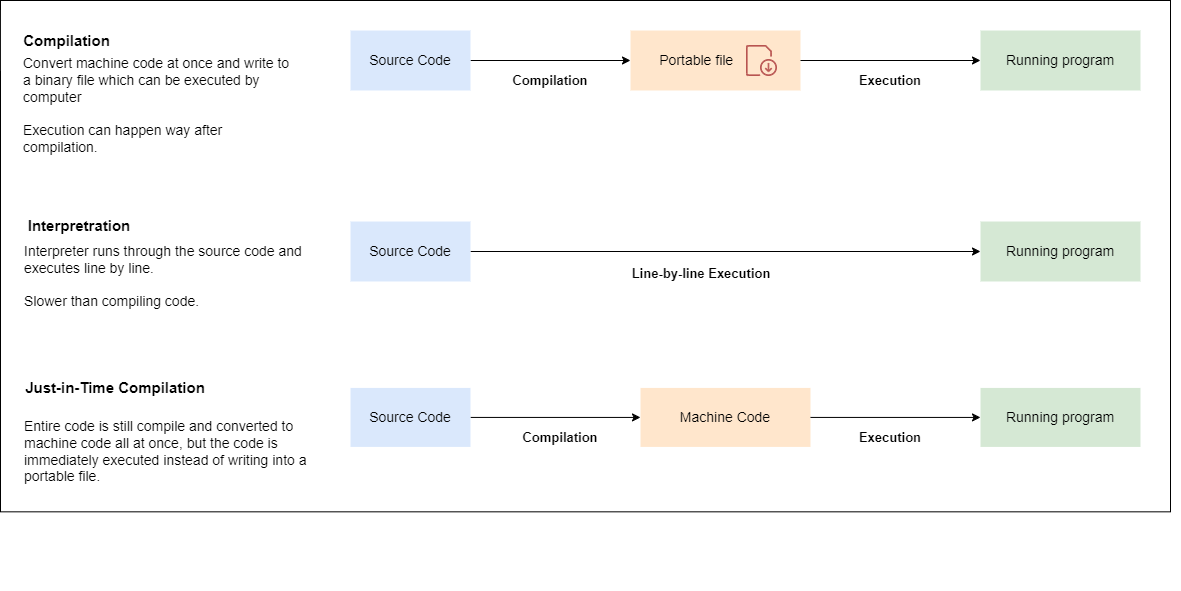Javascript Engine
Overview
A JavaScript engine is a program that interprets and executes JavaScript code. Every browser has its own engine, but the most popular one is Google’s V8, which powers both Google Chrome and Node.js.
Components
Every JavaScript engine has two main components: the call stack and the heap. These are used to manage and store the data and execution contexts while running JavaScript code.
-
Call Stack
- Where functions are executed in a last-in, first-out (LIFO) order.
- It keeps track of the execution context for each function call.
- It helps manage function calls and handles the flow of execution.
-
Heap
- Unstructured pool of memory used for dynamic memory allocation.
- stores objects that the application needs during execution.
Just-in-Time Compilation
Just-in-Time (JIT) compilation is used by JavaScript engines to improve performance. It converts JavaScript code into machine code at runtime, and is then executed immediately. In this scenario, there's no portable file to execute unlike on compiled languages.

How JavaScript Works in the Browser
JavaScript runs inside the browser, just like HTML and CSS.
- JavaScript is a file, just like HTML and CSS
- It can be written inside HTML or linked as a separate file
Using JavaScript in a separate file is better because it keeps things organized.
Adding JavaScript to HTML
To add JavaScript, we use the <script> tag.
- JavaScript can be written inside a
<script>tag in HTML - It can also be linked using the
srcattribute, like CSShref - Multiple script files can be included
Example:
<!DOCTYPE html>
<html>
<head>
<title>JavaScript in HTML</title>
</head>
<body>
<h1>JavaScript in HTML</h1>
<script>
alert("Hello!");
</script>
</body>
</html>
This will show an alert when the page loads.
Using an External JS File
Instead of writing JavaScript inside HTML, we can put it in a separate file.
- Create a file called
script.js - Add JavaScript code inside it
- Link it in HTML using
<script src="script.js"></script>
Example:
<!DOCTYPE html>
<html>
<head>
<title>JavaScript in HTML</title>
</head>
<body>
<h1>JavaScript in HTML</h1>
<script src="script.js"></script>
</body>
</html>
Example: script.js:
alert("You're smart!");
Multiple JS Files
If you have multiple Javscript files, you can also add them the same way:
<!DOCTYPE html>
<html>
<head>
<title>JavaScript in HTML</title>
</head>
<body>
<h1>JavaScript in HTML</h1>
<script src="script.js"></script>
<script src="first-script.js"></script>
<script src="second-script.js"></script>
<script src="third-script.js"></script>
</body>
</html>
Where to Place <script> in HTML
The position of <script> affects how the page loads.
- Placing
<script>at the top delays content loading - Placing
<script>at the bottom lets the page load first - Users see content faster if JavaScript loads last
Example:
<!DOCTYPE html>
<html>
<head>
<title>JavaScript in HTML</title>
</head>
<body>
<h1>Not waiting for JavaScript</h1>
<script src="script.js"></script>
</body>
</html>
Putting <script> at the bottom ensures the page loads before running JavaScript.
Logging to the Console
Instead of showing alerts, we can log messages in the console.
- Use
console.log("message")to print messages - Open the browser console to see the output
- This helps in debugging
Example:
console.log("Hello!");